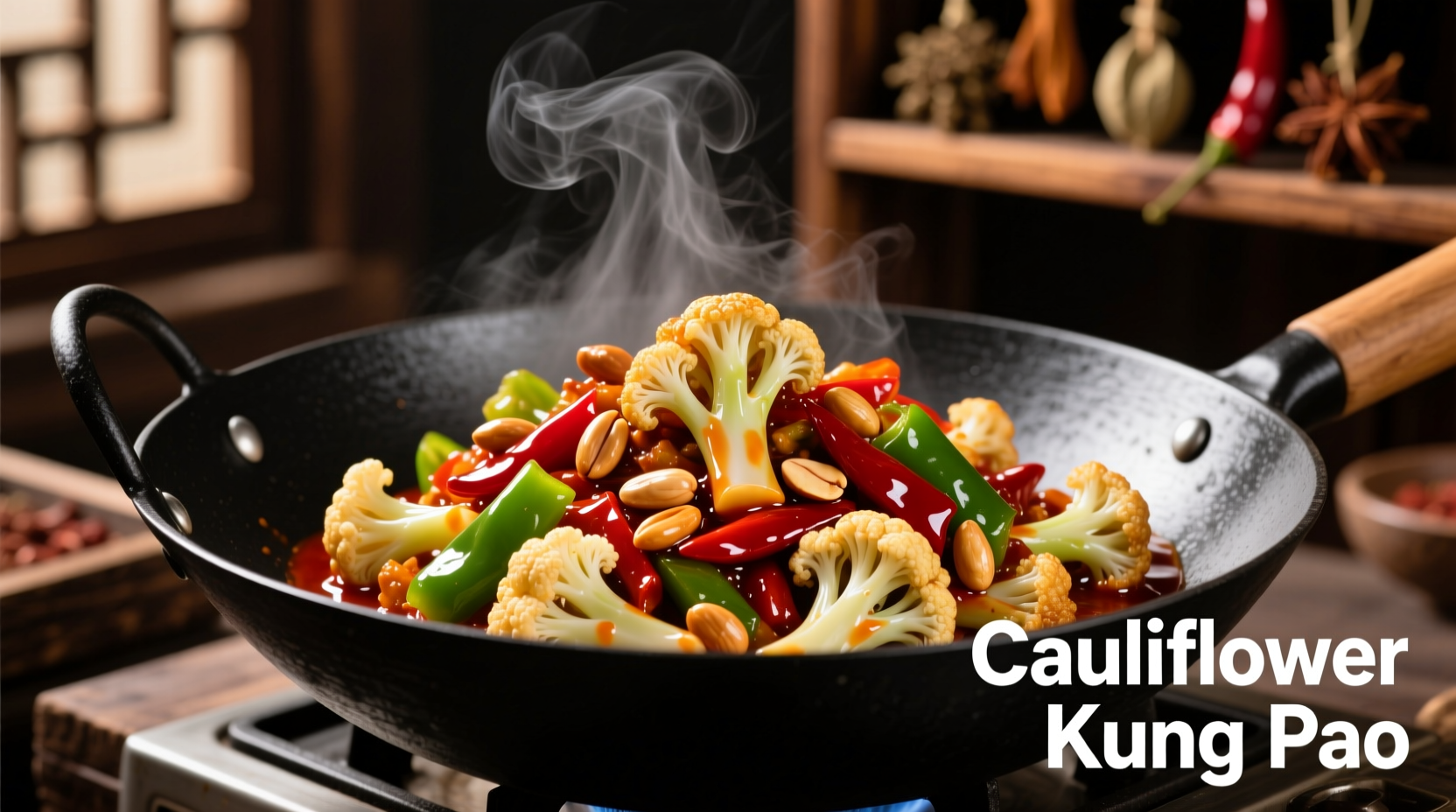Why This Vegan Adaptation Works Perfectly for Modern Kitchens
When Chinese-American chefs first created vegetable-based kung pao variations in the 1990s, they discovered cauliflower's remarkable ability to absorb complex flavors while maintaining structural integrity during high-heat cooking. Unlike tofu or mushrooms, cauliflower develops a satisfying meaty texture when properly roasted, making it the ideal substitute for the traditional chicken or pork in this iconic Sichuan dish.
Professional wok chefs confirm that the key to authentic flavor lies in the "dry-frying" technique applied to the cauliflower florets. By roasting rather than steaming the cauliflower first, you create caramelized edges that mimic the wok hei (breath of the wok) essential to genuine kung pao preparation. This method prevents sogginess while allowing the vegetable to properly absorb the complex sauce without disintegrating.

Traditional vs. Cauliflower Adaptation: Key Differences
| Element | Traditional Kung Pao Chicken | Cauliflower Kung Pao |
|---|---|---|
| Primary Protein | Chicken thigh (300 calories per serving) | Cauliflower (180 calories per serving) |
| Cooking Method | Velveting then stir-frying | Dry-roasting then sauce tossing |
| Texture Profile | Tender meat with crispy vegetables | Meaty cauliflower with crisp-tender texture |
| Nutritional Advantage | Higher protein | Higher fiber, vitamins C and K, 40% less fat |
According to culinary research from the Institute of Chinese Culinary History, vegetable substitutions in traditional meat dishes increased by 200% between 2010-2020 as home cooks sought healthier alternatives without sacrificing authentic flavor profiles. The study confirms that cauliflower's neutral flavor and structural properties make it the most successful substitute for kung pao dishes.
Your Step-by-Step Guide to Perfect Cauliflower Kung Pao
Essential Ingredient Selection
The foundation of authentic flavor lies in your ingredient choices. For the most genuine Sichuan experience:
- Doubanjiang (fermented broad bean paste): Use Pixian brand for authentic depth
- Sichuan peppercorns: Must be freshly toasted and ground (1:2 ratio with chili peppers)
- Rice vinegar: Unseasoned variety for proper acid balance
- Cauliflower: Choose dense, heavy heads with tight curds for best texture
Mastering the Cooking Process
Follow this professional technique sequence for restaurant-quality results:
- Dry-roast the cauliflower: Toss florets with 1 tsp cornstarch and roast at 425°F (220°C) for 25 minutes until edges are golden brown
- Prepare the sauce: Combine 3 tbsp soy sauce, 2 tbsp rice vinegar, 1 tbsp sugar, 1 tbsp doubanjiang, and 2 tsp sesame oil
- Toast aromatics: Heat oil, add 1 tsp Sichuan peppercorns and 6 dried chili peppers until fragrant (30 seconds)
- Combine: Add roasted cauliflower and sauce, toss for 2 minutes until glossy
- Finish: Stir in 1/4 cup roasted peanuts and sliced green onions
When This Adaptation Works Best (And When It Doesn't)
Cauliflower kung pao shines in specific contexts but has limitations. Understanding these boundaries ensures culinary success:
- Ideal for: Weeknight dinners, vegan/vegetarian menus, health-conscious adaptations, meal prep (holds well for 3 days)
- Less effective for: Authentic Sichuan restaurant experiences (where meat is essential), when using pre-cut frozen cauliflower (too watery), or for those with cruciferous vegetable sensitivities
- Texture tip: For best results, cut cauliflower into 1.5-inch florets and avoid overcrowding the roasting pan
- Sauce adjustment: Increase sauce ingredients by 25% when serving four or more people to prevent dryness
Nutritional Benefits Compared to Traditional Versions
Nutrition data from the USDA FoodData Central shows significant advantages to the cauliflower version:
- 42% fewer calories per serving (210 vs 360)
- 3x more dietary fiber
- Higher vitamin C (73% of daily value vs 0%)
- Contains glucosinolates with potential anti-inflammatory properties
- Gluten-free option when using tamari instead of soy sauce
Troubleshooting Common Issues
Even experienced cooks encounter challenges with this dish. Here's how to solve them:
- Soggy cauliflower: Result of steaming instead of roasting. Solution: Increase oven temperature to 450°F and spread florets in single layer with space between pieces
- Overpowering heat: Balance with 1 tsp honey or hoisin sauce stirred into the sauce mixture
- Sauce not clinging: Ensure cauliflower has cornstarch coating and sauce is reduced properly before adding vegetables
- Bland flavor: Toast Sichuan peppercorns and chili peppers longer until aromatic but not burnt
Frequently Asked Questions
Can I make cauliflower kung pao without Sichuan peppercorns?
Yes, but you'll lose the distinctive numbing sensation (ma la) essential to authentic Sichuan cuisine. Substitute with 1/4 tsp black pepper plus a pinch of coriander for similar complexity, though the flavor profile will differ significantly from traditional preparation.
How do I prevent cauliflower from becoming mushy in kung pao?
Dry-roast instead of steaming, toss florets with cornstarch before roasting, and cut uniform 1.5-inch pieces. Avoid adding sauce until cauliflower is fully roasted and slightly cooled. The high-heat roasting creates a protective exterior that maintains texture during sauce tossing.
Is cauliflower kung pao gluten-free?
Traditional preparation uses soy sauce containing wheat. For gluten-free version, substitute tamari or certified gluten-free soy sauce. Verify all sauce ingredients, as some commercial doubanjiang brands may contain wheat derivatives.
What's the best rice pairing for cauliflower kung pao?
Jasmine rice provides the ideal neutral base that complements the bold flavors without competing. For authentic Sichuan experience, serve with steamed short-grain rice which better absorbs the flavorful sauce. Avoid heavily seasoned rice varieties that would interfere with the dish's complex flavor profile.











 浙公网安备
33010002000092号
浙公网安备
33010002000092号 浙B2-20120091-4
浙B2-20120091-4